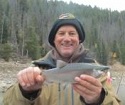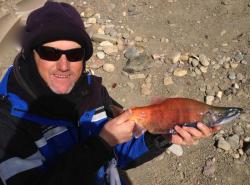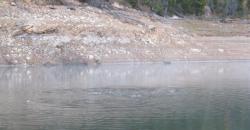 Autumn is a time of plenty for anglers, as cooling water temperatures spark feeding binges among a variety of gamefish. For some species, however, fall ushers in an equally primal urge, causing fish to migrate en masse toward spawning areas. Such is the case with many members of the trout and salmon family, including the kokanee salmon. A downsized freshwater version of the Pacific sockeye salmon, the kokanee is nonetheless hard fighting and great tasting.
Autumn is a time of plenty for anglers, as cooling water temperatures spark feeding binges among a variety of gamefish. For some species, however, fall ushers in an equally primal urge, causing fish to migrate en masse toward spawning areas. Such is the case with many members of the trout and salmon family, including the kokanee salmon. A downsized freshwater version of the Pacific sockeye salmon, the kokanee is nonetheless hard fighting and great tasting.
Plankton eaters that mature in four years, kokanee salmon can reach weights of 3 to 5 pounds, but 1-pounders are the most common catches in many waters.
In states where stocking efforts produce fishable populations, the fall kokanee run is a huge draw for anglers. “It’s a really fun bite, there’s nothing not to love about it,” says veteran fishing guide Bernie Keefe of Granby, Colorado.
“As water temperatures fall into the 55- to 60-degree range, usually sometime in September in Colorado, salmon begin migrating from their summertime haunts in the main lake toward the spawning grounds,” he explains.
Normally bright silver in color, kokanee undergo a dramatic transformation as spawning draws near. Both sexes develop reddish sides and green heads, but the male’s red caste is most pronounced. Amorous bucks also develop a humped back and hooked jaw—also called a kype.

As schools of fiery red salmon gather in predictable places, the fishing can be nothing short of amazing. “You can get into some pretty fast action,” Keefe grins.
Kokanee spawn over rubble, gravel and sand in tributary streams and along lake shorelines. This narrows the search, but Keefe adds another nugget of information on their whereabouts.
“They typically return to the area where they were stocked,” he says. “Inlets and boat ramps are two of the most common areas.”
To pinpoint the best lakes and stocking points, Keefe recommends contacting local fisheries biologists and bait shops. “Most lakes are a little different, so pre-trip research can really pay off,” he says.
On the tactical front, Keefe offers two surefire plans of attack.
“One great option is to get on the water before sunrise and quietly wait for the fish to start porpoising,” he says. “As soon as it’s light enough to see where they are, use your electric trolling motor to sneak within casting range. Just be careful not to crowd them or it’s game over.”
Salmon often school close to shorelines, making bank fishing a great alternative. “You don’t need a boat to enjoy the action,” he says.
When fishing the morning bite, Keefe wields a lightweight spinning outfit armed with either a bobber rig or small spoon.
Given the kokanee’s soft mouth and spirited fight, he typically spools up with a forgiving monofilament mainline like 6-pound-test Berkley Trilene XL. “You can use superline with a fluorocarbon or mono leader, but set your drag really loose or the fish will tear the hooks out,” he cautions.
The bobber setup includes a 1/16- to 1/8-ounce micro-jig tipped with a 2 1/2-inch Berkley PowerBait Power Tube, positioned two to six feet below a small float.
“Either slip- or fixed floats work in early fall, but fixed floats are the rule once temperatures drop below freezing,” he adds.
Keefe avoids adding split shot for ballast. “Don’t expect the fish to pull the bobber under,” he notes. “A lot of times they just lay it on its side, so you can’t have any extra weight on the line or you’ll miss fish.”
He does sweeten the jig with bait, however. “Two or three waxworms work great, as do kernels of shoepeg corn,” he says.
To fish the float rig, he lobs a long cast past fish dimpling the surface. “Let it sit a minute,” he says. “Most mornings there’s enough breeze to ripple the surface and work the jig just enough to attract nearby salmon.”

After the initial pause, he pulls the rig about six inches, lets it sit again, and repeats the process until his float is out of the strike zone.
Spoons are another productive presentation. Keefe favors something long and slender, like an Acme Kastmaster or Johnson Splinter, in the 1/16- to 1/8-ounce class.
Retrieves are slow and gently animated. “One rotation of the reel handle per second is fast enough,” he says. “Spice it up by raising and lowering the rodtip six inches to a foot, reeling the whole time. Most fish hit when the spoon begins to fall.”
Keefe cautions that once the sun hits the water, salmon sound and the near-surface bite dies. “Wind, clouds and waves can prolong the action a little, but not for long,” he adds.
At that point, he recommends trolling small willow-leaf spinners 1.5 to 2 mph in the top 10 feet of the water column. “The fish will move around the immediate area, so you have to go looking for them,” he explains.
Keefe says the fall kokanee bite typically lasts from September until ice covers the lakes, usually sometime in November or December.
“Kokanee are great table fare,” he adds. “But they die after spawning, and by the end of the season are looking pretty rough, like the swimming dead.”
As a rule of thumb, he says, “As long as the meat is orange, it’s good to cook. Once it turns pale, however, put it in the smoker.”
